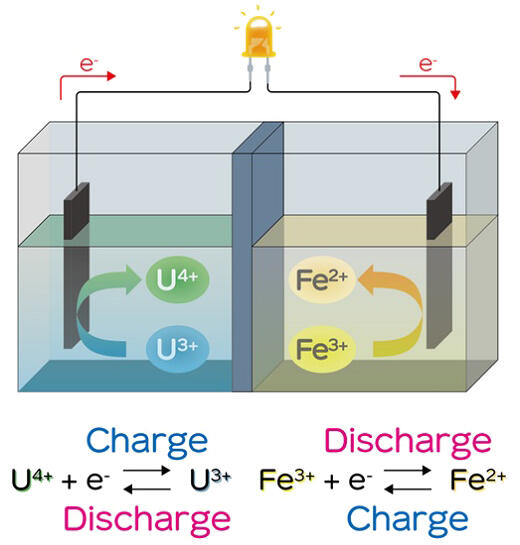A research team including Assistant Principal Researcher Kazuki Ouchi, Researcher Katsuhiro Ueno, and Senior Principal Researcher Masayuki Watanabe of the NXR Development Center, Nuclear Science Research Institute at the Japan Atomic Energy Agency (JAEA), has succeeded for the first time in the world in developing a uranium storage battery that can utilize depleted uranium, which was previously considered a useless waste material.

Provided by JAEA
Natural uranium only contains 0.7% uranium-235, but it can be used as fuel for nuclear power plants after enrichment to 3%-5%. Approximately 16,000 ton of the remaining uranium-238, known as depleted uranium, has accumulated in Japan as a waste material because of the storage space and costs involved.
To make efficient use of this depleted uranium, the research team worked on developing a redox flow battery that uses uranium as the active material. The capacity of redox flow batteries can be easily increased by fluidizing the active materials in both electrodes and storing them in tanks. Vanadium batteries have been put to practical use overseas, but issues in this regard include storage loss and deterioration of the active material.
In the newly developed demonstration model (approximately 10 cm), a mixture of an organic solvent and ionic liquid was used as the electrolyte and the negative electrode was constructed with tetravalent and trivalent uranium used as the active material. Notably, the positive electrode contained iron ions in a similar solvent. The battery charges when uranium becomes trivalent from tetravalent and discharges when it becomes tetravalent from trivalent. In experimentation, circulating the liquid caused an electric current to flow, turning on an LED light. The measured EMF was 1.3 V.
"We began this research with the idea that if depleted uranium can be used in storage batteries, it can go from being a waste material to being a treasure trove," said Ouchi, further adding, "Now that we have demonstrated that uranium batteries are possible, from April, we are going to add a tank and make a larger battery. In the future, we hope to optimize the balance of electricity supply and demand by storing surplus electricity and supplying it when needed. Also, the uranium active material negligibly deteriorates, which may result in lower power generation costs."
This article has been translated by JST with permission from The Science News Ltd. (https://sci-news.co.jp/). Unauthorized reproduction of the article and photographs is prohibited.




